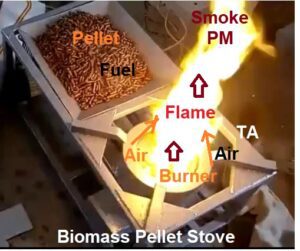Table of Contents
ToggleHeating Calculation of Biomass Fuel
- The heating value of biomass fuel is essential for determining the energy content, which is crucial for designing boilers and furnaces or evaluating the overall efficiency of a heating system.
- Biomass fuels include wood, agricultural residues, and other organic matter, and their energy potential is usually quantified by the calorific value or heat content.
- There are two main calorific values to consider:
- Higher Heating Value (HHV) or Gross Calorific Value (GCV): This includes the latent heat of vaporization of water in the combustion products.
- Lower Heating Value (LHV) or Net Calorific Value (NCV): This excludes the latent heat of vaporization of water, giving a more realistic estimate of the usable heat from biomass combustion.
Formulas for Biomass Heating Calculation
Determine Biomass Composition
-
- Biomass fuel consists of moisture, volatile matter, fixed carbon, and ash.
- The energy content depends on the type of biomass, its moisture content, and the chemical composition (mainly carbon, hydrogen, and oxygen).
Obtain the Calorific Value (HHV/LHV)
-
- Calorific values can be obtained from experimental data or standard tables for various types of biomass.
- For example, typical HHVs of some biomass fuels:
- Wood: 18-20 MJ/kg
- Agricultural residues: 14-17 MJ/kg
- Straw: 12-16 MJ/kg
- Pellets: 16-19 MJ/kg
Account for Moisture Content:
-
- Moisture significantly impacts the net energy released during combustion.
- More moisture means more energy is used to evaporate the water content, reducing the available heat.
- The formula to adjust the calorific value for moisture content:
LHV=HHV−2.44×M
-
- Where:
- LHV: Lower Heating Value in MJ/kg
- HHV: Higher Heating Value in MJ/kg
- M: Moisture content as a decimal (e.g., 20% moisture is 0.20)
- 2.44 MJ/kg is the latent heat of vaporization of water.
Example: If wood has an HHV of 19 MJ/kg and moisture content of 20%, the LHV would be:
LHV=19−2.44×0.20=18.512MJ/kg
- Where:
Calculate the Required Biomass Quantity for Heating:
- The amount of biomass fuel required for heating can be calculated by using the equation:Mass flow rate of Biomass Required (kg)=Heat Demand (MJ/)LHV of Biomass (MJ/kg)Where:
- Heat Demand: The total energy required to heat a space or power a system, typically in MJ or kWh.
- LHV of Biomass: The adjusted lower heating value accounting for moisture and specific fuel type.
Example: If a boiler requires 500 MJ of energy and the LHV of the biomass is 18 MJ/kg, the biomass quantity required would be:
Biomass Required=500/18=27.78kg
- Efficiency of the Heating System:
- Consider the efficiency of the boiler or furnace when calculating the total biomass required:
- Effective Biomass Required (kg)=Biomass Required (kg)/Boiler Efficiency
- If the boiler efficiency is 80% (0.80):Effective Biomass Required =27.7/80.80 =34.73kg
Selection of Biomass stoves based on fuel characteristics

You can refer:
- Scope of Biomass Pellet Making Machine: its type and applications
- Benefit and Types of Biomass Pellet Stove for Cooking
Basics Steps for Heating Value Calculation
Determine Biomass Composition
Biomass fuel contains several components, including:
- Carbon (C)
- Hydrogen (H)
- Oxygen (O)
- Nitrogen (N)
- Sulfur (S)
- Moisture (M)
- Ash content
A proximate and ultimate analysis can be done to determine the percentages of these components in the biomass fuel.
Calculate Higher Heating Value (HHV)
The Dulong’s Formula is often used to estimate the HHV of biomass based on its elemental composition:
HHV=33.91C+144.43(H−O/8)+9.42S
Where:
- HHV is in MJ/kg
- C, H, O, and S are the percentages by mass of carbon, hydrogen, oxygen, and sulfur in the fuel
The constants 33.91, 144.43, and 9.42 are derived from the heat of combustion of these elements.
Example Calculation:
- Carbon (C) = 45%
- Hydrogen (H) = 5%
- Oxygen (O) = 40%
- Sulfur (S) = 0.5%
Substituting these into Dulong’s formula:
HHV =33.91(45)+144.43(5−408)+9.42(0.5)
=1963.95MJ/kg
Calculate Lower Heating Value (LHV)
- To find the Lower Heating Value (LHV), subtract the latent heat of vaporization of water generated during combustion from the HHV.
- The LHV can be calculated as:
LHV=HHV−(2.442×H×(1−M100))
Where:
- HHH is the hydrogen content in the fuel
- MMM is the moisture content in the fuel
Example Calculation:
- Hydrogen (H) = 5%
- Moisture content (M) = 10%
- HHV = 19.64 MJ/kg (from the previous step)
LHV=19.64−(2.442×5×(1−10100))=8.651MJ/kgSo, the lower heating value is approximately 8.65 MJ/kg.
Adjust for Moisture Content
- If the fuel has a high moisture content, its actual calorific value will be lower. The formula to adjust the LHV for moisture content is:
Adjusted LHV=LHV×(1−M100)Where:
- MMM is the moisture content as a percentage.
For a moisture content of 10%, the LHV is adjusted as:
Adjusted LHV=8.65×(1−10100))=8.65×0.9=7.785MJ/kg
So, the final adjusted LHV of the biomass fuel is 7.79 MJ/kg.
Conclusion:
- The heating calculation for biomass fuel involves determining its chemical composition, calculating its higher heating value (HHV), and adjusting for the moisture content to determine the lower heating value (LHV).
- Biomass fuels typically have lower energy density compared to fossil fuels, but they are renewable and widely used in industries like power generation, heating, and biofuel production.